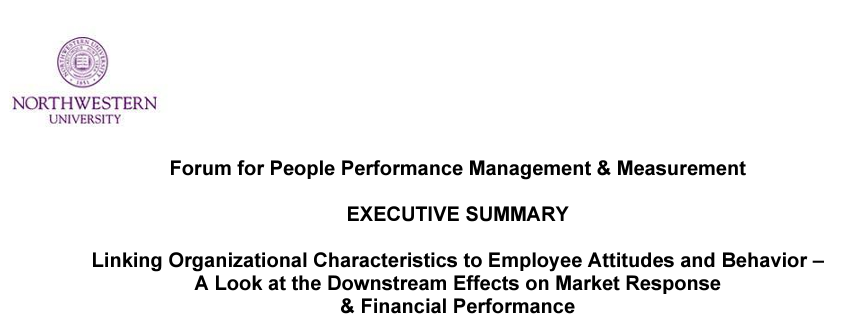The 2008 Empirical Study Linking Employee and Customer Engagement to Profitability
 This study by the Forum for People Performance Management and Measurement in 2008 analyzed 100 companies in the media industry, including over 5,600 employees, 269 manager groups, and responses from 37,000 consumers, and the financial results of the companies to identify not only the connection between employee and customer engagement and profitability but also the factors that lead to greater employee and customer engagement. This article is the first in a series for the next three months highlighting the history of the Enterprise Engagement Alliance on its 15th anniversary.
This study by the Forum for People Performance Management and Measurement in 2008 analyzed 100 companies in the media industry, including over 5,600 employees, 269 manager groups, and responses from 37,000 consumers, and the financial results of the companies to identify not only the connection between employee and customer engagement and profitability but also the factors that lead to greater employee and customer engagement. This article is the first in a series for the next three months highlighting the history of the Enterprise Engagement Alliance on its 15th anniversary. Key Findings Linking Employee and Customer Satisfaction With Financial Results
Methodology—Linking Perceptions to Reality
A detailed study of 100 companies, their employees, managers, and customers conducted in 2008 found a compelling link between employee and customer satisfaction and financial results. In terms of the management strategy with the biggest impact on results, the study finds that open two-way communication between stakeholders and management dominates the factors predictive of better financial results.
Explains James Oakley, who conducted the study and who is now Professor of Marketing at Lewis University in Illinois, “This particular study was part of the larger Readership Institute that was housed in Medill at Northwestern in the late 1990s through the early 2000s.” Frank Mulhern, a Professor at Medill and Academic Director of the Forum for People Performance Management and Measurement at the time, was familiar with the Readership Institute, and reached out to Oakley to see if the data could be used to support the Forum’s goals: to better understand the interrelationships between employee satisfaction and employee engagement, the organizational characteristics favorable to these attitudes, and their downstream market and financial consequences.
More specifically, do employee satisfaction and employee engagement have unique antecedents, factors that favor their occurrence; second, does each have an impact on subsequent market and/or financial outcomes; and third, are the effects direct or indirect in their impact on the outcome variables?
Those were the questions Oakley was able to address in this comprehensive 2008 study: Linking Organizational Characteristics to Employees and Behavior, using a bounty of data obtained from the much larger study. This report was produced by the Forum under the direction of Bruce Bolger, Co-Founder of the Forum in 1996. The findings of this study were the basis both for the creation of the Enterprise Engagement Alliance in 2009 and the subsequent Engaged Company Stock Index study from 2012 to 2018 funded in part by EGR International, which demonstrating a clear connection between high levels of employee, customer, and community engagement with share price performance over a six year period.
Key Findings Linking Employee and Customer Satisfaction With Financial Results 
Here is what the researchers found by correlating key employee engagement, satisfaction, organizational culture and climate, human resources systems, market characteristics, and the market and financial performance of 100 media companies. See below for details on the methodology.
Two-way organizational communication is critical. The key organizational characteristic for explaining employee satisfaction was organizational communication, a measure of organizational climate. Organizational communication represents a measure of the downward communication in the organization, i.e., the effectiveness with which information about the organization is sent and received by employees, and the upward communication in the organization, i.e., the effectiveness with which information is sent from employees to people in higher level positions. The analysis in this study shows that organizational communication accounts for 45% of the variance in employee satisfaction (R2=0.449), while none of the other 13 organizational characteristics under study were found to have a significant impact on employee satisfaction.
Employee engagement begins with satisfaction. Interpreting these results, to achieve a motivated workforce, organizational managers must first ensure that their employees are satisfied, and one of the keys to creating a satisfied workforce is the development of an effective communication environment, both up and down the organization. Further means of motivating employees come from the interaction between managers and employees with regards to supportiveness and the extent to which managers establish and communicate expectations for performance. In addition, employees are more motivated when their job is effectively designed in terms of autonomy and clearly defined roles.
The employee-customer connection. Employee satisfaction has a direct an positive impact on customer satisfaction, while employee engagement has an indirect effect on customer satisfaction through two intervening mechanisms: 1) Employee engagement has a direct and positive influence on an organization’s level of market orientation (a set of market-related organizational behaviors comprised of customer focus, coordination, and market focus) and 2) through its direct effect on market orientation, employee engagement has an indirect effect on customer behavior, which in turn directly influences customer satisfaction.
Link between customer satisfaction and financial performance. Continuing with the outcomes analysis, customer satisfaction directly influences financial performance, in this case represented by profitability. The effects of employee satisfaction and employee engagement on financial performance are indirect through their impact on customer satisfaction.
Employee satisfaction and employee engagement have both direct and indirect effects on subsequent market and financial outcomes. Employee satisfaction directly influences customer satisfaction, while employee engagement’s effects on customer satisfaction are indirect through market orientation and customer behavior.
The detailed analysis finds that through their direct and indirect impact on customer satisfaction, employee satisfaction and employee engagement positively influence financial performance.
Methodology—Linking Perceptions to Reality
To establish a link between employee and customer satisfaction with organizational outcomes required a significant investment and an ambitious attempt to correlate detailed objective and subjective data often nearly impossible to obtain. It would be irresponsible to publish the report’s conclusions without providing details on the methodology. Because of the large budget involved with the broader study of which this was a part, the researchers were able to draw upon a very large pool of data.
To accomplish their goal, the researchers focused on 100 companies in the media industry that provided the researchers with access to the employees, management groups, and customer information needed to conduct the surveys. The companies were selected out of a total group of 1,500 and were stratified by size. Each company had a project manager to work with the researcher. A single industry was selected to rule out distortions that could arise from measuring unrelated industries. About 5,600 employee surveys were collected from the 100 companies to identify employee satisfaction, engagement, and culture and climate using the same engagement survey; 269 management groups were surveyed to evaluate the maturity of internal human resources systems, and 110,000 surveys, with three $1 bills attached, were mailed to media consumers in the 100 markets involved in the study. A total of 37,036 customers completed the survey, a 34% response rate, with the number of respondents per market ranging from 271 to 472, with a mean 366.7. These respondents completed an 88-item survey measuring a number of factors related to media use and sources of entertainment and information. (A number of variables were derived from this information, from which two were selected for utilization in this study – a frequency of purchase index to measure customer behavior and a customer satisfaction index.) To test for non-response bias, the researchers followed up the mail survey with a telephone survey of 2,000 non-responders.
Click here for the original report which includes complete information on the methodology.
ESM Is Published by The EEA: Your Source for Effective Stakeholder Management, Engagement, and Reporting
Through education, media, business development, advisory services, and outreach, the Enterprise Engagement Alliance supports professionals, educators, organizations, asset managers, investors, and engagement solution providers seeking a competitive advantage by profiting from a strategic and systematic approach to stakeholder engagement across the enterprise. Click here for details on all EEA and ESM media services.
1. Professional Education on Stakeholder Management and Total Rewards
- Become part of the EEA as an individual, corporation, or solution provider to gain access to valuable learning, thought leadership, and marketing resources to master stakeholder management and reporting.
- The only education and certification program focusing on Stakeholder Engagement and Human Capital metrics and reporting, featuring nine members-only training videos that provide preparation for certification in Enterprise Engagement.
- EEA books: Paid EEA participants receive Enterprise Engagement for CEOs: The Little Blue Book for People-Centric Capitalists, a quick implementation guide for CEOs; Enterprise Engagement: The Roadmap 5th Edition implementation guide; a comprehensive textbook for practitioners, academics, and students, plus four books on theory and implementation from leaders in Stakeholder Management, Finance, Human Capital Management, and Culture.
2. Media
- ESM at EnterpriseEngagement.org, EEXAdvisors.com marketplace, ESM e–newsletters, and library.
- RRN at RewardsRecognitionNetwork.com; BrandMediaCoalition.com marketplace, RRN e-newsletters, and library.
- EEA YouTube Channel with over three dozen how-to and insight videos and growing with nearly 100 expert guests.
3. Fully Integrated Business Development for Engagement and Total Rewards
Strategic Business Development for Stakeholder Management and Total Rewards solution providers, including Integrated blog, social media, and e-newsletter campaigns managed by content marketing experts.
4. Advisory Services for Organizations
Stakeholder Management Business Plans; Human Capital Management, Metrics, and Corporate Sustainability Reporting for organizations, including ISO human capital certifications, and services for solution providers.
5. Outreach in the US and Around the World on Stakeholder Management and Total Rewards
The EEA promotes a strategic approach to people management and total rewards through its e-newsletters, web sites, and social media reaching 20,000 professionals a month and through other activities, such as:
- Association of National Advertisers Brand Engagement 360 Knowledge Center to educate brands and agencies.


















